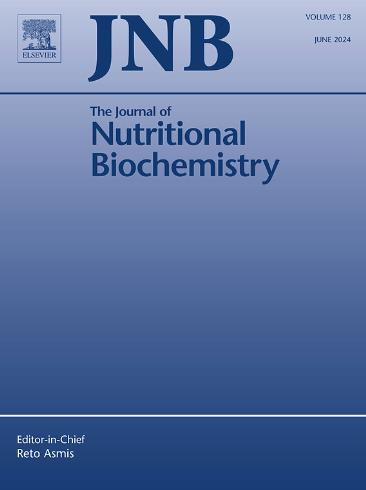多组学分析揭示了不同脂肪能量比的热量限制饮食对大鼠体重和糖脂代谢的明显影响。
IF 4.9
2区 医学
Q1 BIOCHEMISTRY & MOLECULAR BIOLOGY
引用次数: 0
摘要
为了探讨不同脂肪能量比热量限制(CR)饮食对健康的不同影响,将50只雄性Wistar大鼠随机分为5组:2个随意组分别饲喂正常(ND-AL)或高脂肪(HF-AL)饮食,3个CR组分别饲喂低[10% (cal)脂肪,LF-CR]、中[35% (cal)脂肪,MF-CR]和高[45% (cal)脂肪,HF-CR]脂肪能量比饮食,持续10周。在三个CR组中,HF-CR的减肥效果最为显著,但也加重了糖脂代谢紊乱。在HF-CR组中,与LF-CR组相比,观察到与葡萄糖代谢紊乱相关的肠道微生物群(例如Collinsella和enterorhabduus)的增加。此外,与LF-CR组相比,MF-CR组和HF-CR组中参与肝脏糖异生、糖原合成和胰岛素信号传导的基因表达水平显著降低。进一步分析表明,肠habduus可能通过调节胆碱代谢来调节葡萄糖激酶调节因子(glucokinase regulator, GCKR)的基因表达,从而影响葡萄糖代谢。我们的研究强调了在CR饮食中保持适当的脂肪能量比的重要性,通过平衡饮食脂肪、肠道微生物群和葡萄糖代谢来促进健康的体重减轻。本文章由计算机程序翻译,如有差异,请以英文原文为准。
Multi-omics analyses revealed the distinct effects of calorie restriction diets with different fat-to-energy ratios on body weight and glycolipid metabolism in rats
To explore the distinct effects of different fat-to-energy ratio calorie restriction (CR) diets on health, 50 male Wistar rats were randomly assigned to five groups: two ad libitum groups were fed with either normal (ND–AL) or high–fat (HF–AL) diets, and three CR groups were fed with respective low-(10% [cal] fat, LF–CR), medium-(35% [cal] fat, MF–CR) and high-(45% [cal] fat, HF–CR) fat-to-energy ratio diets for 10 weeks after obesity modeling. Among the three CR groups, HF-CR had the most pronounced weight loss effect, but it also exacerbated glycolipid metabolism disorders. In the HF-CR group, an increase in gut microbiota associated with glucose metabolism disorder (e.g., Collinsella and Enterorhabdus) was observed compared to the LF-CR group. Additionally, there was a significant decrease in the expression levels of genes involved in hepatic gluconeogenesis, glycogen synthesis, and insulin signaling in the MF-CR and HF-CR groups when compared to the LF-CR group. Further analysis indicated that Enterorhabdus may potentially regulate the gene expression of the glucokinase regulator (GCKR) by modulating choline metabolism, thereby impacting glucose metabolism. Our study emphasizes the importance of maintaining an appropriate fat-to-energy ratio in CR diets to promote healthy weight loss by balancing dietary fat, gut microbiota, and glucose metabolism.
求助全文
通过发布文献求助,成功后即可免费获取论文全文。
去求助
来源期刊

Journal of Nutritional Biochemistry
医学-生化与分子生物学
CiteScore
9.50
自引率
3.60%
发文量
237
审稿时长
68 days
期刊介绍:
Devoted to advancements in nutritional sciences, The Journal of Nutritional Biochemistry presents experimental nutrition research as it relates to: biochemistry, molecular biology, toxicology, or physiology.
Rigorous reviews by an international editorial board of distinguished scientists ensure publication of the most current and key research being conducted in nutrition at the cellular, animal and human level. In addition to its monthly features of critical reviews and research articles, The Journal of Nutritional Biochemistry also periodically publishes emerging issues, experimental methods, and other types of articles.
 求助内容:
求助内容: 应助结果提醒方式:
应助结果提醒方式:


